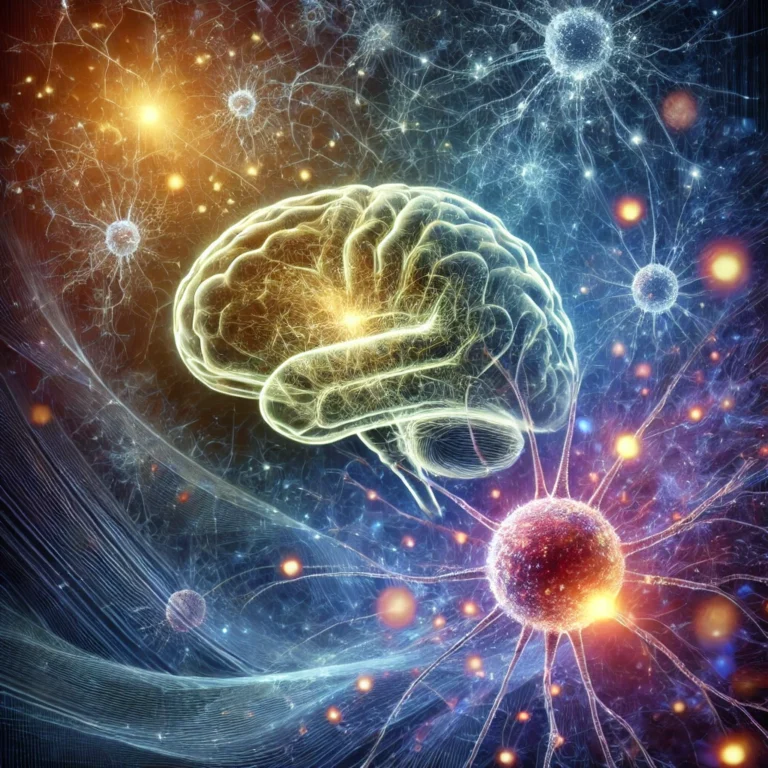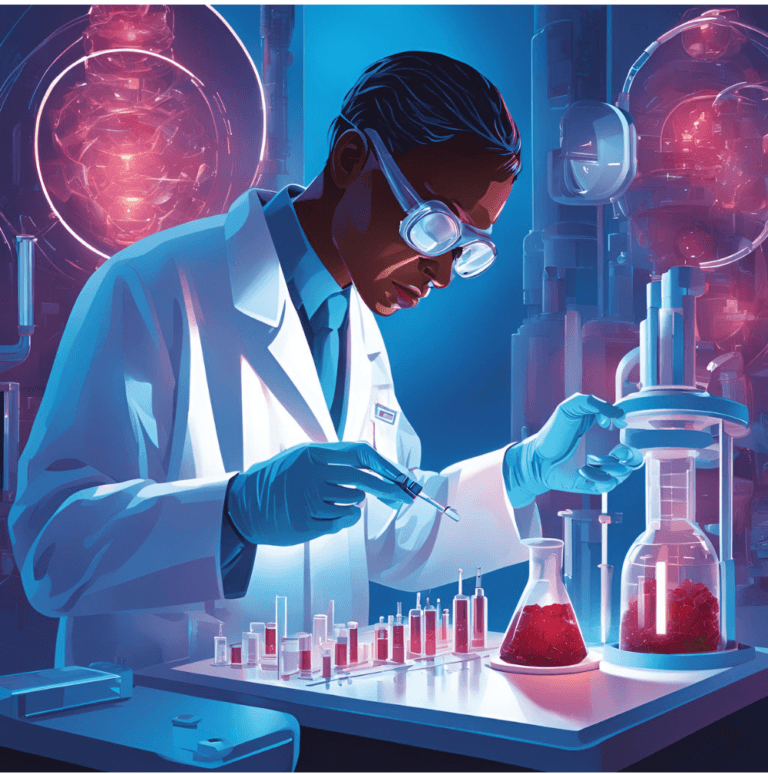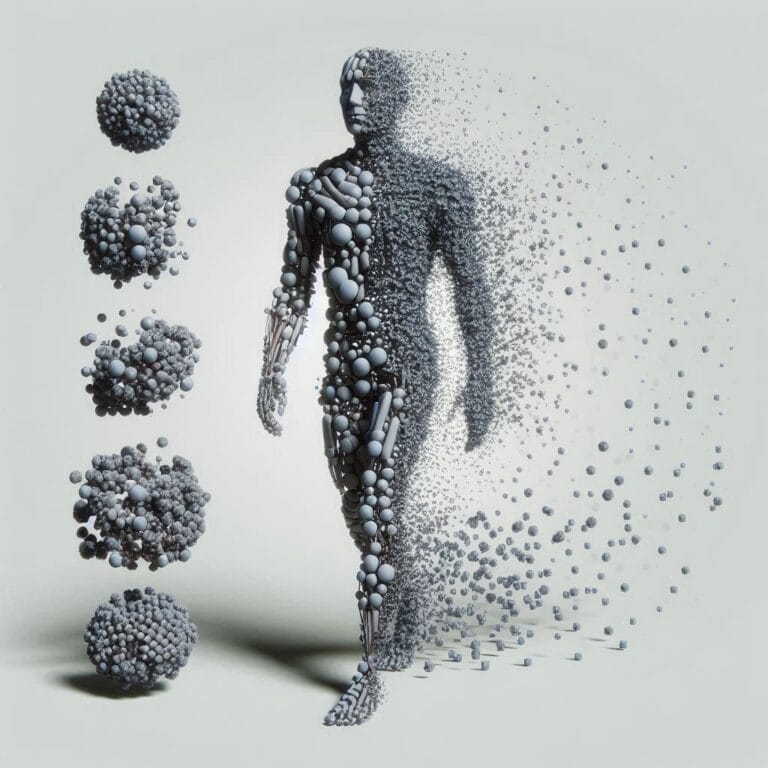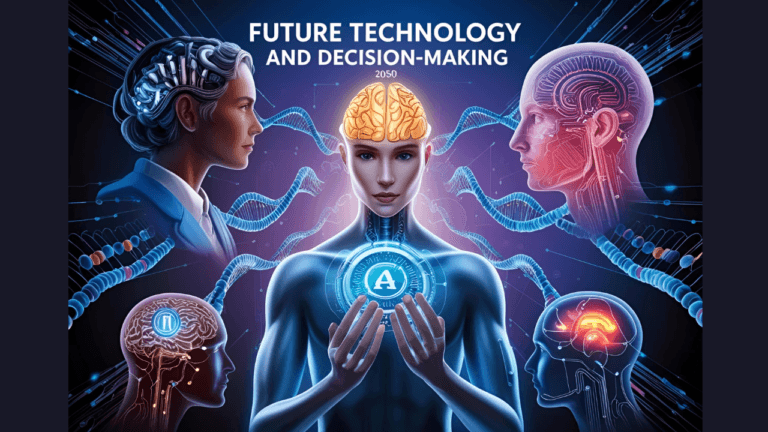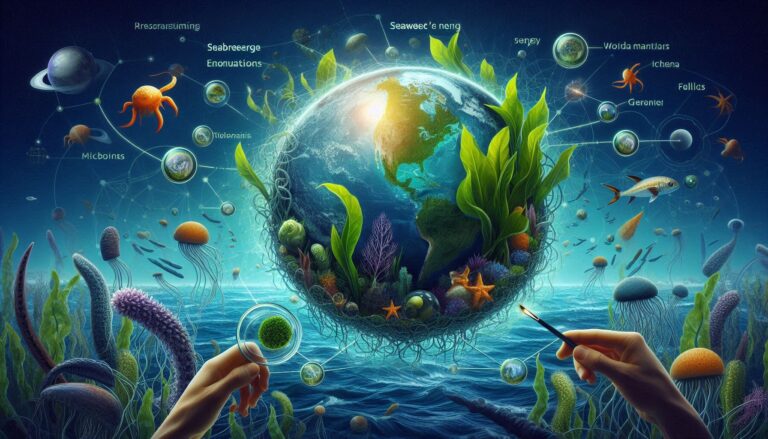Introduction
Oceans play a crucial role in regulating Earth’s climate, producing over 50% of the planet’s oxygen and absorbing around 30% of human-generated CO₂ emissions. However, modern industrial activities have severely impacted marine ecosystems. Over 90% of global fish stocks are either fully exploited or overfished, and ocean acidification is damaging coral reefs and marine biodiversity. Climate change has also disrupted ocean currents, altering marine food webs and reducing global fish yields.
Marine permaculture offers a revolutionary solution to these challenges. By mimicking natural marine ecosystems, it helps restore biodiversity, enhance ocean-based food production, and combat climate change. This regenerative approach to sea farming utilizes kelp forests, artificial reefs, and multi-species aquaculture to create self-sustaining marine habitats.
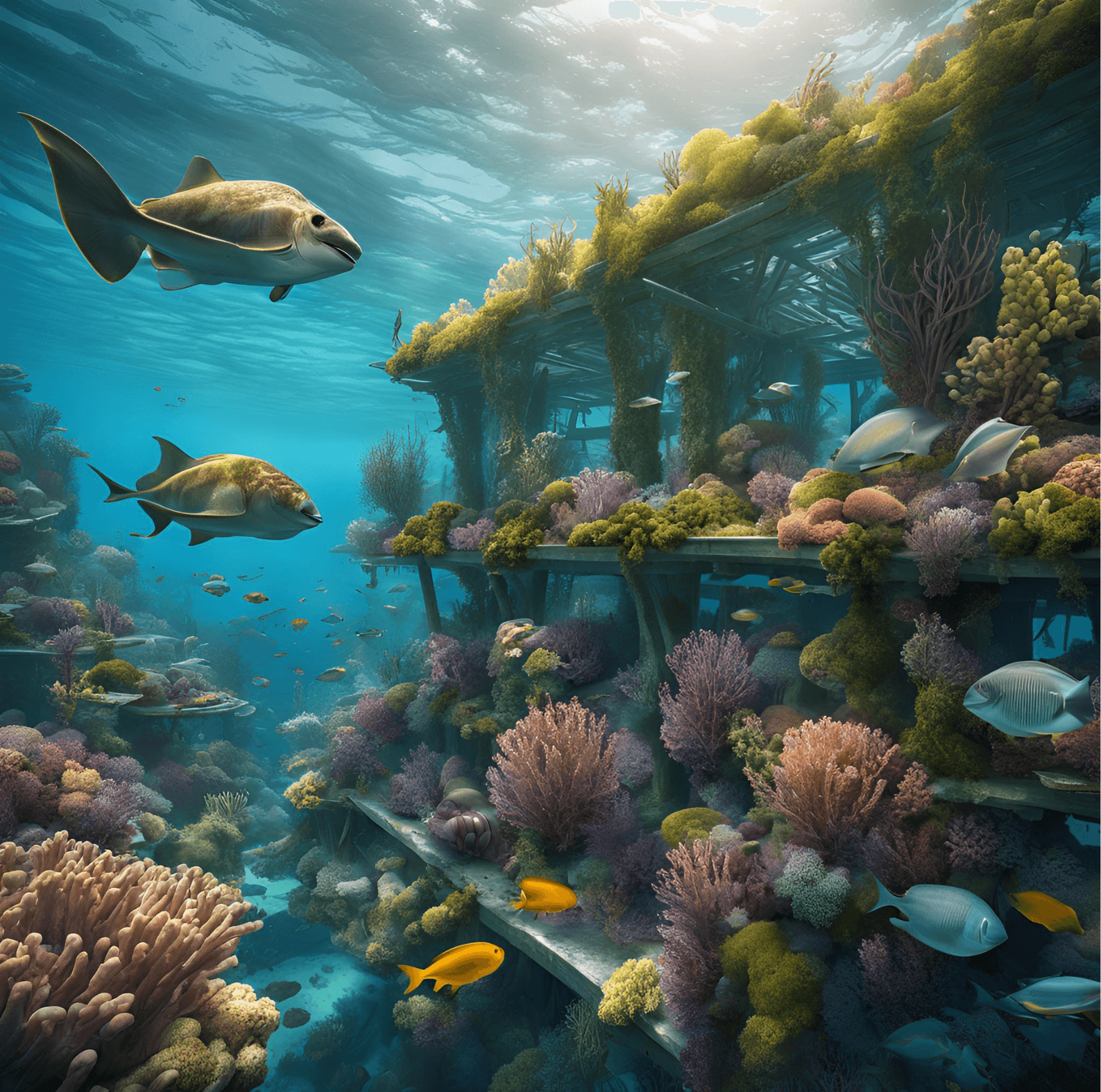
As we look toward the future, the concept of marine permaculture 2040 envisions large-scale aquatic permaculture systems capable of addressing food security and climate change. This blog will explore what is marine permaculture, its core principles, and how it can revolutionize sustainable ocean farming.
What is Marine Permaculture?
Definition & Concept
Marine permaculture is a regenerative ocean farming approach that integrates marine ecology with sustainable aquaculture practices. It restores damaged marine ecosystems by cultivating kelp forests, shellfish, and fish in a balanced environment while promoting biodiversity. Unlike traditional fish farming, which often leads to environmental degradation, Aquatic Agroecology mimics natural ocean systems to ensure long-term sustainability.
The term was popularized by Dr. Brian von Herzen , founder of the Climate Foundation, who developed wave-powered marine permaculture arrays (MPAs) to restore kelp ecosystems and enhance ocean productivity.
Core Principles of Marine Permaculture
- Ecosystem Mimicry –Aquatic Agroecology replicates natural marine ecosystems to restore balance in ocean environments. Kelp forests, for example, absorb excess CO₂, oxygenate the water, and provide shelter for marine life.
- Biodiversity Enhancement – Unlike monoculture fish farms, Aquatic Agroecology promotes a multi-trophic system where various species interact symbiotically, leading to a healthier and more resilient marine environment.
- Sustainability & Low-Impact Farming – Traditional aquaculture often contributes to ocean pollution, disease outbreaks, and habitat destruction. In contrast, Aquatic Agroecology uses renewable energy sources, such as wave-powered pumps, to bring up nutrient-rich deep ocean water that fosters kelp and marine life growth.
Key Components of Marine Permaculture
Kelp Forests
- Kelp is one of the fastest-growing plants on Earth, capable of growing up to 2 feet per day.
- Absorbs CO₂ and nitrogen, reducing ocean acidification and pollution.
- Provides habitat and breeding grounds for fish, crustaceans, and other marine organisms.
Artificial Reefs
- Structures made from biodegradable materials that attract marine life and restore damaged habitats.
- Encourage coral growth and improve fish populations in overfished areas.
Integrated Multi-Trophic Aquaculture (IMTA)
- Cultivates multiple species in a mutually beneficial environment (e.g., fish, seaweed, and shellfish).
- Reduces waste accumulation as seaweed absorbs excess nutrients from fish waste.
- Creates a self-sustaining cycle that mimics a natural oceanic ecosystem.
By implementing Eco-Marine Cultivation, we can restore marine biodiversity, sequester carbon, and create a sustainable, high-yield ocean farming model for the future.
The Benefits of Marine Permaculture
Environmental Benefits
Carbon Sequestration through Kelp Forests
- Kelp forests act as natural carbon sinks, absorbing CO₂ from the atmosphere at rates up to 20 times faster than terrestrial forests.
- By exporting carbon to the deep ocean when kelp detaches and sinks, marine permaculture helps mitigate climate change in a long-term, sustainable way.
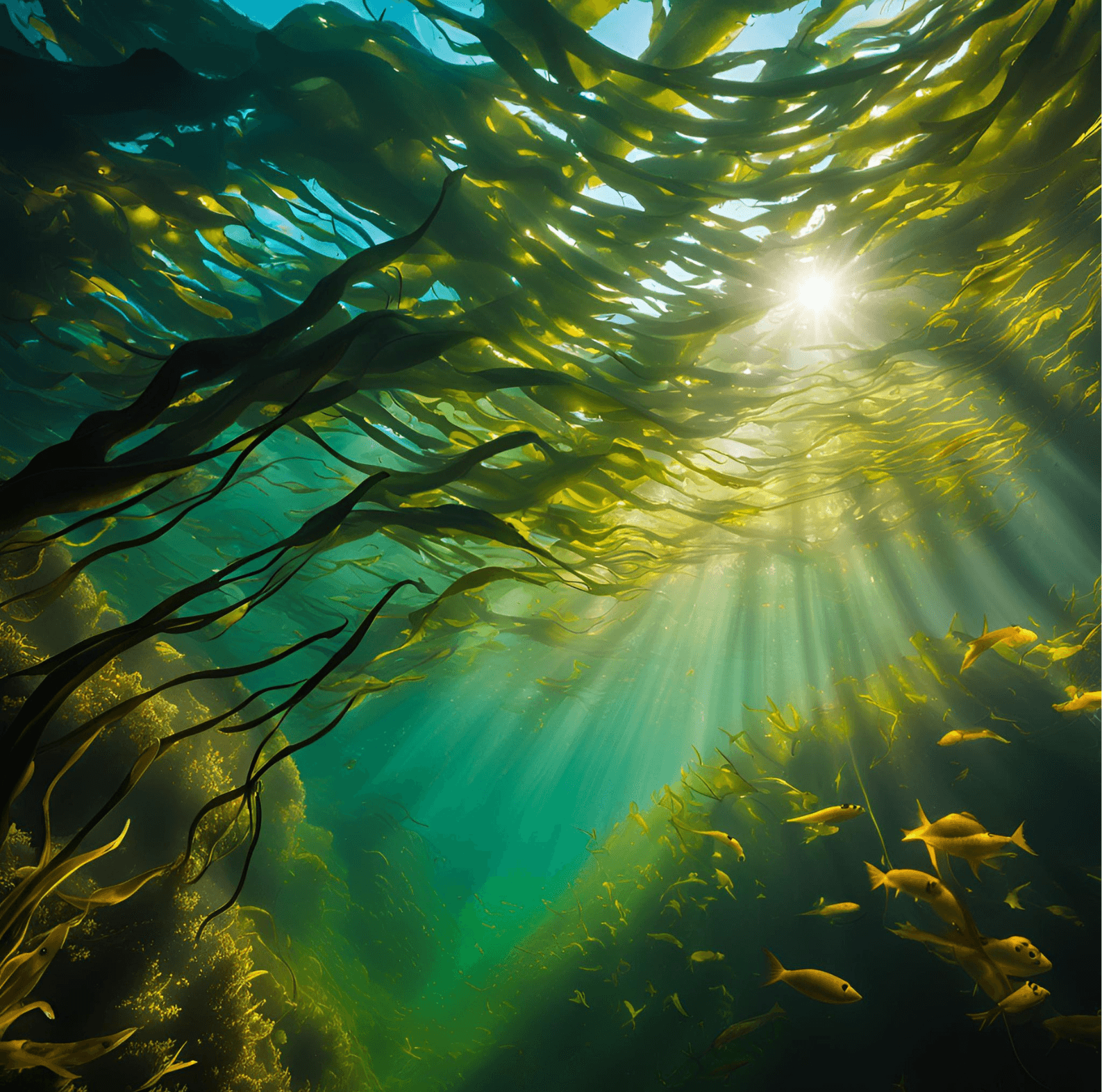
Restoration of Marine Biodiversity and Habitats
- Kelp and seaweed provide habitats for fish, shellfish, and marine invertebrates, supporting entire ocean food chains.
- Artificial reefs and integrated multi-trophic aquaculture (IMTA) encourage species diversification and enhance marine ecosystem resilience.
Reduction of Ocean Acidification and Eutrophication
- Excess CO₂ in seawater leads to ocean acidification, which damages coral reefs and shellfish populations.
- Kelp absorbs CO₂ and releases oxygen, helping to stabilize pH levels in coastal waters.
- By absorbing excess nitrogen and phosphorus, seaweed farming prevents harmful algal blooms, which cause dead zones in marine environments.
Economic Benefits
Sustainable Seafood Production
- Unlike conventional fish farming, which contributes to overfishing and pollution, marine permaculture supports regenerative aquaculture, producing high-protein, low-impact seafood such as seaweed, shellfish, and herbivorous fish.
- Global seaweed production is projected to reach $26 billion by 2026, offering profitable opportunities for sustainable marine businesses.
Job Creation in Coastal Communities
- Marine permaculture can revitalize struggling fishing communities by providing jobs in kelp farming, seaweed processing, and marine habitat restoration.
- In regions where fishing industries have collapsed due to overfishing, sea farming can create new, stable employment opportunities.
Social Benefits
Improved Food Security
- Seaweed is a nutrient-rich superfood, containing essential vitamins, minerals, and omega-3 fatty acids.
- Aquatic Agroecology offers a sustainable, climate-resilient food source in regions vulnerable to land-based agricultural challenges.
Enhanced Resilience to Climate Change
- Coastal communities benefit from kelp forests acting as natural storm barriers, reducing wave energy and coastal erosion.
- By restoring healthy marine ecosystems, marine permaculture helps stabilize fish stocks and create long-term food security.
Case Study: The Climate Foundation’s Eco-Marine Cultivation Arrays
The Climate Foundation has successfully implemented wave-powered kelp farming systems in the Philippines, restoring fisheries and providing sustainable livelihoods for coastal villages. By scaling up these projects globally, marine permaculture can protect biodiversity, capture carbon, and support ocean-dependent communities.
Marine Permaculture 2040: A Vision for the Future
By 2040, marine permaculture could emerge as a mainstream climate solution, transforming ocean-based food production and carbon sequestration. With increasing global awareness of climate change and food security challenges, governments and industries are beginning to invest in large-scale marine farming projects.
Key Goals for Marine Permaculture by 2040
Scaling Up Kelp Farming to Sequester Billions of Tons of CO₂
- Global kelp forests currently absorb an estimated 200 million tons of CO₂ annually.
- If Aquatic Agroecology is scaled globally, kelp farms could remove gigatons of CO₂ from the atmosphere, significantly slowing climate change.
Creating Millions of Jobs in Sustainable Blue Carbon Farming
- Large-scale marine permaculture projects could generate millions of new jobs in ocean-based industries, including:
-
-
- Kelp cultivation & processing
- Sustainable seafood harvesting
- Blue carbon credit markets
-
Restoring Degraded Marine Ecosystems Worldwide
- Over 90% of historical kelp forests have disappeared due to climate change, pollution, and overfishing.
- Eco-Marine Cultivation aims to restore lost kelp forests, re-establishing critical ecosystems and bringing balance to oceanic food chains.
The Role of Technology and Innovation
Automated Kelp Farming Systems
- Wave-powered deep-sea upwelling pumps bring nutrient-rich water to the surface, enabling year-round kelp growth even in nutrient-poor regions.
- Self-sustaining kelp farms could be deployed in deep ocean waters, reducing dependency on coastal regions.
AI and Drones for Monitoring Aquatic Agroecology Sites
- AI-driven satellite imagery can track the health of kelp farms, detecting growth rates, environmental stressors, and biodiversity changes.
- Underwater drones equipped with sensors and cameras can monitor fish populations, water quality, and structural integrity of artificial reefs.
A Sustainable Future for Our Oceans
By 2040, marine permaculture could be a cornerstone of global climate strategies, helping to mitigate climate change, enhance food security, and restore marine ecosystems. As research and investment accelerate, the widespread adoption of sustainable Blue Carbon Farming will shape a healthier, more resilient ocean for future generations.
Sea Farming: The Role of Marine Permaculture
What is Sea Farming?
Sea farming, also known as marine aquaculture, involves the cultivation of marine organisms such as fish, shellfish, and seaweed for food, biofuels, and industrial products. It is a key solution to meeting global food demands as wild fish stocks continue to decline.
Traditional Sea Farming vs. Marine Permaculture
| Aspect | Traditional Sea Farming (Aquaculture) | Marine Permaculture |
|---|---|---|
| Method | Monoculture of fish, shrimp, or seaweed | Multispecies farming integrating kelp, shellfish, and fish |
| Environmental Impact | Often leads to habitat destruction, water pollution, and disease spread | Restores ecosystems, improves water quality, and enhances biodiversity |
| Sustainability | Requires high resource inputs (e.g., fish feed, antibiotics) | Self-sustaining, relying on natural ocean currents and ecosystems |
| Economic Viability | Dependent on subsidies and intensive management | Provides long-term financial benefits with minimal inputs |
Problems with Traditional Blue Carbon Farming:
- Overfishing of wild stocks to produce fish meal for farmed species.
- Excess nutrient runoff from farms leading to dead zones in the ocean.
- High antibiotic use, increasing the risk of antibiotic-resistant bacteria.
How Marine Permaculture is Revolutionizing Sea Farming
Sustainable Food Production
- Seaweed and shellfish farms require no fertilizers, freshwater, or land.
- Seaweed absorbs carbon dioxide and nitrogen, improving water quality and creating a healthier environment for marine life.
Biofuels and Bioplastics
- Algae and seaweed can be converted into renewable biofuels, reducing reliance on fossil fuels.
- Seaweed-derived bioplastics offer a compostable, ocean-friendly alternative to petroleum-based plastics.
Reducing Pressure on Wild Fish Stocks
- By producing seafood sustainably, Aquatic Agroecology reduces overfishing and supports ocean biodiversity.
- Fish farms can incorporate kelp and shellfish, reducing the environmental footprint of farmed fish.
Case Study: Norway’s Integrated Seaweed and Fish Farms
Norwegian aquaculture companies are integrating kelp farms with salmon aquaculture, reducing nutrient pollution and providing a healthier, more sustainable seafood system. This circular farming approach is gaining global attention as a model for sustainable Blue Carbon Farming.
Aquatic Permaculture: Beyond the Oceans
What is Aquatic Permaculture?
Aquatic permaculture extends the principles of marine permaculture to freshwater systems such as lakes, rivers, and wetlands. It focuses on restoring ecosystems, improving water quality, and creating sustainable food systems.
Key Benefits of Aquatic Permaculture
Restoring Freshwater Biodiversity
- Wetlands and lakes host diverse ecosystems, but pollution and habitat destruction have led to the decline of fish, amphibians, and aquatic plants.
- Permaculture-based restoration projects reintroduce native plants, filter pollutants, and revive healthy aquatic habitats.
Improving Water Quality
- Floating aquatic plant farms absorb heavy metals, nitrates, and excess nutrients, preventing toxic algal blooms.
- Constructed wetlands act as natural water filters, purifying wastewater and storm runoff before it reaches major water bodies.
Supporting Sustainable Food Production
- Aquaponics integrates fish farming with vegetable cultivation, creating a closed-loop system where fish waste fertilizes plants, and plants filter water for fish.
- Freshwater seaweed farming can provide high-protein, nutrient-rich food without the need for synthetic fertilizers.
Examples of Aquatic Permaculture Projects
Integrated Fish and Vegetable Farming (Aquaponics)
- In Singapore and the Netherlands, urban aquaponics systems are producing sustainable seafood and vegetables in cities, reducing the need for land-based agriculture.
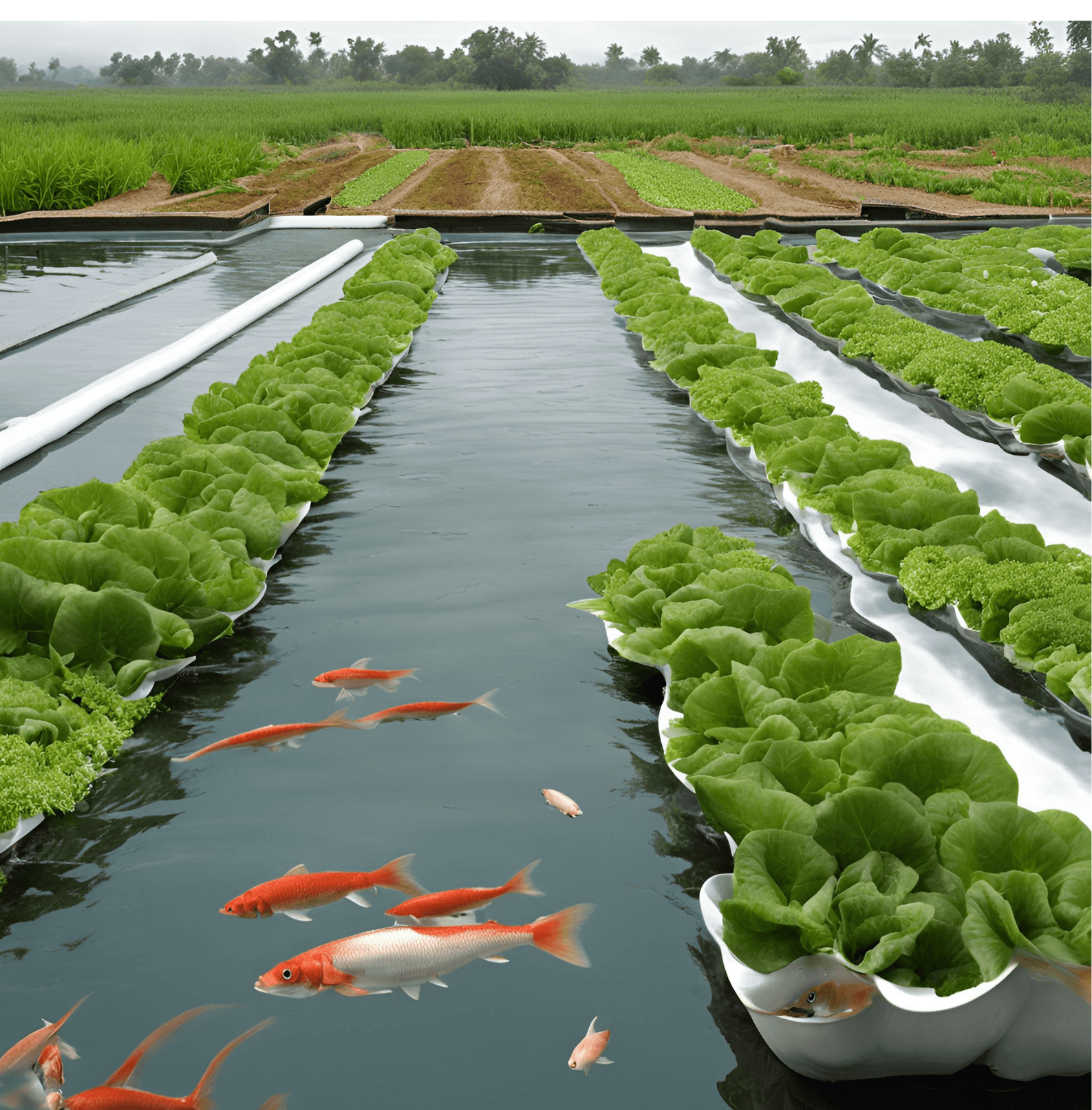
Wetland Restoration Initiatives
- The Kissimmee River Restoration Project (Florida, USA) has successfully restored over 40 square miles of wetlands, improving biodiversity and reducing pollution in the Everglades.
The Future of Aquatic Permaculture
As climate change intensifies and water scarcity increases, aquatic permaculture offers nature-based solutions to food production, ecosystem restoration, and climate resilience. Expanding sustainable water farming could reshape global agriculture while protecting vital freshwater resources.
Challenges and Solutions in Marine Permaculture
While marine permaculture presents a sustainable solution for ocean restoration and food security, several challenges hinder its widespread adoption.
Key Challenges
High Initial Costs and Funding Requirements
- Establishing large-scale marine permaculture farms requires significant investment in infrastructure, technology, and research.
- Costs include seaweed cultivation systems, monitoring equipment, and maintenance.
- Lack of financial incentives discourages private-sector involvement.
Regulatory and Legal Barriers
- Permits for maritime farming operations often involve complex regulations.
- Environmental protection laws may restrict Blue Carbon Farming activities.
- In many countries, the legal framework for marine permaculture is underdeveloped.
Public Perception and Awareness
- Marine permaculture is a relatively new concept, and many people are unaware of its benefits for food security, climate change mitigation, and biodiversity.
- Public skepticism regarding seaweed-based products (biofuels, bioplastics, and alternative proteins) affects market demand.
Potential Solutions
Government Incentives and Subsidies
- Policies that offer grants, tax benefits, or low-interest loans can encourage investment in Aquatic Agroecology.
- Example: The European Union’s Blue Economy Fund supports sustainable ocean projects, including seaweed farming.
Public-Private Partnerships (PPP)
- Collaboration between governments, research institutions, and private companies can fund large-scale projects.
- Example: The Ocean Rainforest project in the Faroe Islands has successfully integrated private investment and research funding to scale up sustainable seaweed farming.
Education and Outreach Programs
- Increasing public awareness through documentaries, policy discussions, and educational programs.
- Incorporating marine permaculture studies into university curricula can help train the next generation of ocean farmers and conservationists.
- Example: The Global Seaweed STAR project provides training and support for seaweed farmers in developing nations.
The Future of Marine Permaculture
The future of marine permaculture is bright, with emerging technologies and global collaborations driving its expansion.
Emerging Technologies in Marine Permaculture
Floating Eco-Marine Cultivation Platforms
- Autonomous, solar-powered floating farms can grow kelp and shellfish in deep-sea environments.
- These platforms sequester carbon, restore ocean health, and provide sustainable food sources.
- Example: Marine permaculture pioneer Dr. Brian von Herzen has developed prototypes of offshore kelp forests, using wave-powered upwelling systems to enhance nutrient circulation.
Genetic Engineering to Enhance Kelp Growth
- Scientists are studying ways to boost kelp resilience to rising ocean temperatures.
- Genetic modification and selective breeding could increase seaweed productivity, making it a more viable alternative to land-based agriculture.
- Example: Researchers at the University of Southern California are investigating heat-resistant strains of kelp to improve climate resilience.
Global Collaboration for Aquatic Agroecology
International Agreements
- Ocean conservation policies, such as the UN Decade of Ocean Science (2021–2030), promote sustainable blue economy initiatives, including marine permaculture.
- Countries are collaborating on marine protected areas (MPAs) to support ecosystem-based Blue Carbon Farming.
Knowledge Sharing and Capacity Building
- Developing nations with coastline-dependent economies can benefit from marine permaculture.
- Organizations like The Nature Conservancy and World Resources Institute provide training and funding to local communities for regenerative sea farming projects.
Call to Action
As individuals, we can support marine permaculture by:
✅ Choosing sustainable seafood and seaweed-based products.
✅ Advocating for policy changes that support ocean conservation.
✅ Spreading awareness about the benefits of Aquatic Agroecology.
Marine permaculture offers a transformative solution to some of the most pressing global challenges: climate change, food security, and marine ecosystem degradation. By integrating seaweed farming, regenerative aquaculture, and ocean restoration, this approach not only provides sustainable food and biofuels but also enhances ocean biodiversity.
However, to realize its full potential, continued research, investment, and policy support are crucial. Overcoming financial, regulatory, and awareness challenges will require collective action from governments, industries, and individuals.
🌊 Join the movement to protect our oceans! Share this blog, support sustainable seafood initiatives, and explore more resources on marine conservation and permaculture. 🚀
1. Vertical Ocean Farms: The Next Frontier in Sustainable Food Production
“Marine permaculture is transforming the future of ocean-based agriculture, and innovative approaches like vertical ocean farms are leading the way. These multi-layered farming systems optimize space, enhance marine biodiversity, and contribute to sustainable seafood production.”
2. Cutting-Edge Technology in Marine Biology and Conservation
“From AI-driven marine monitoring to underwater robotics, technology is reshaping marine permaculture. Our article on cutting-edge marine biology explores how scientific advancements are improving conservation efforts and ecosystem restoration in ocean environments.”
3. AI in Oceanography: Revolutionizing Marine Research
“Artificial intelligence is playing a pivotal role in ocean research, from mapping deep-sea ecosystems to monitoring kelp forests in marine permaculture systems. Learn more about how AI in oceanography is revolutionizing marine science and conservation.”
4. Plastic-Eating Enzymes: A Breakthrough in Marine Pollution Cleanup
“Microplastic pollution poses a major threat to marine permaculture systems. However, researchers are developing plastic-eating enzymes that could break down plastic waste in ocean environments, offering a potential solution to this growing crisis.”
5. Deep-Sea Microplastic Remediation: Effective Water Solutions
“Protecting marine permaculture sites from pollution is crucial for maintaining ecosystem balance. Discover the latest innovations in deep-sea microplastic remediation and how they can help restore the health of our oceans.”


